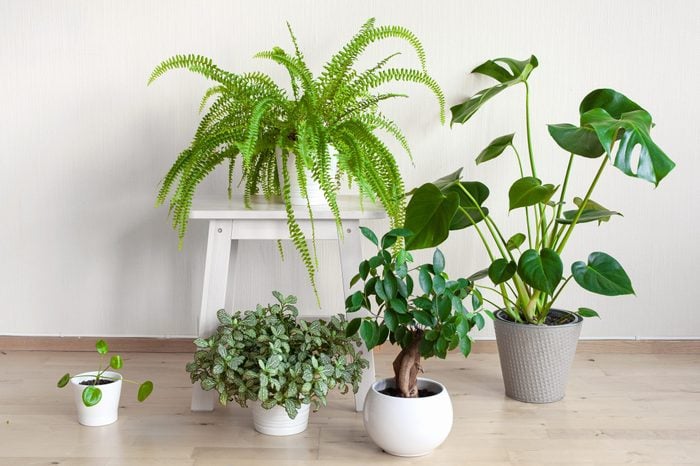
Easy low-light indoor plants
You don’t need a green thumb to grow the low-light indoor plants on our list. They’re low-maintenance, easy to care for and have pretty lenient lighting needs. To begin caring for your indoor plant, whether it’s a type of succulent, small-space plant or detoxifying plant, you’ll first want to figure out the type of lighting it needs. Does it need direct or indirect sunlight? Can it thrive with artificial light or almost no light at all? Does it prefer low, medium or bright light for the best growing conditions?
Houseplants can survive in a variety of environments, and knowing more about your plant will help you figure out the best place to put it—a hoya in the entryway, a parlor palm in a windowless corner or a bromeliad near the kitchen sink, for instance. These low-light indoor plants are simple to keep alive for both advanced gardeners and novices, and we’ve got the perfect shade-loving options to add to your home.
Get Reader’s Digest’s Read Up newsletter for more plant tips, cleaning, travel, tech, humor and fun facts all week long.
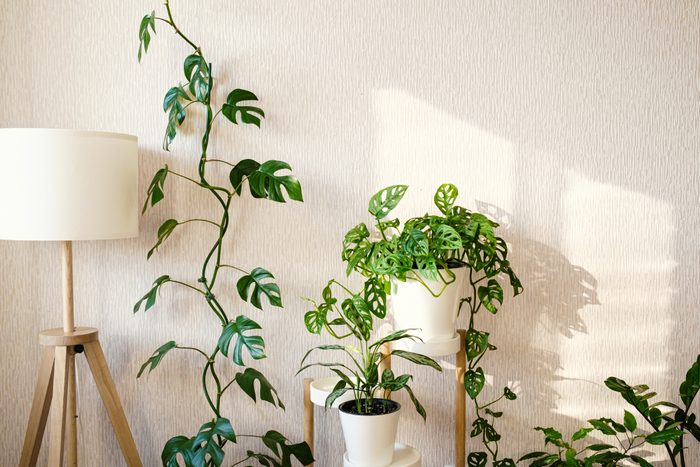
Lighting tips for low-light plants
Caring for your low-light plants might feel confusing, but it’s not that big of a mystery. Just study your plants’ needs and the windows in your home, then follow the light (and these general guidelines).
- For low-light indoor plants that need indirect light, look for an east-facing or northeast-facing window, where it will get morning sun.
- If your indoor plant needs direct light, pick a west-facing or southwest-facing window for afternoon sun.
- If needed, try utilizing window coverings, such as partially closed blinds, to create softer indirect light.
- If you live in a region with harsh seasons and have plants that need some sunlight to survive, consider shifting their placement. During the winter months, move your houseplants from the darker corners of a room to a window area, so they can get more direct sunlight. During the summer months, you might consider moving those plants back to the corner, away from the severe afternoon sun.
- If your space doesn’t have any natural light, such as a basement, a bathroom or an office with no windows, don’t worry. You can supplement the light exposure to your low-light indoor plant by using an artificial source of light, such as a grow light.
Need additional plant-care and plant-watering tips? If your low-light indoor plants are sporting brown edges on their leaves, it may be a sign of incorrect watering.
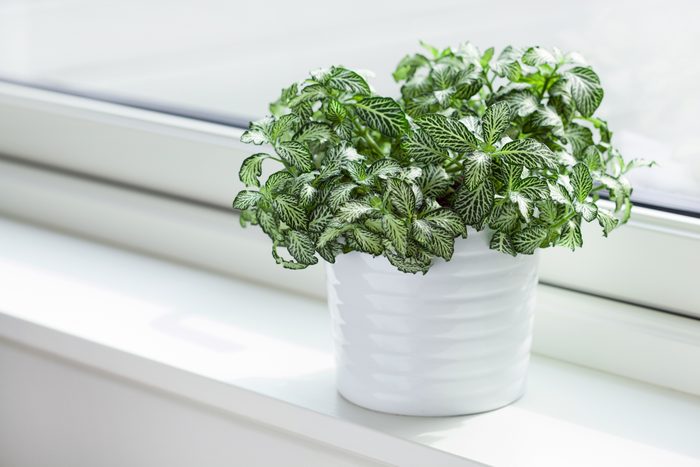
Nerve plant
Fittonia
Light exposure needs: Low to medium light
Thanks to its green leaves brightened with white, pink or red veins, Fittonias, also known as nerve plants, are ideal for adding big color in a small space, says Justin Hancock, horticulturist for Costa Farms. While this tropical plant tolerates low light, it does require a good amount of plant watering. “It prefers moist soil and average to high humidity,” Hancock says. And while it quickly wilts when it gets too dry, it doesn’t require much to revive the plant. Plus, it serves as a good reminder to water your thirstiest houseplants.
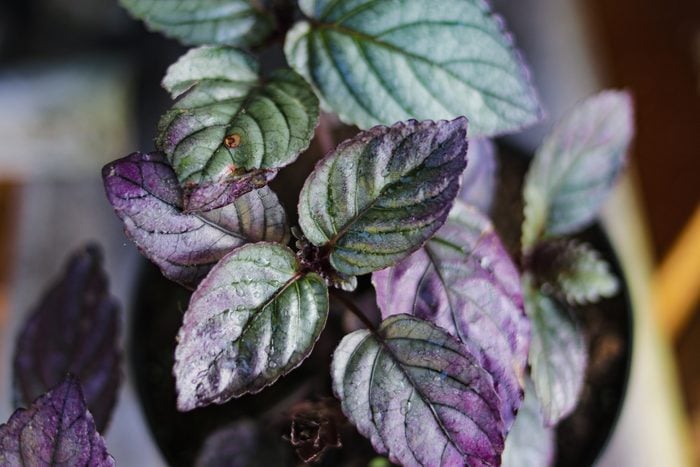
Purple waffle plant
Hemigraphis
Light exposure needs: Medium to bright light (indirect)
A cute and charming tabletop option, the purple waffle plant does indeed have purple leaves with a decidedly waffle-like texture. It’s a small indoor plant that likes to stay moist, and because it’s low maintenance, low growing and happy in medium to bright light, it’s great for terrariums and makes decorating with plants simple. If you notice its purple color fading, try moving it closer to the window, where it can soak in a bit more sunlight.
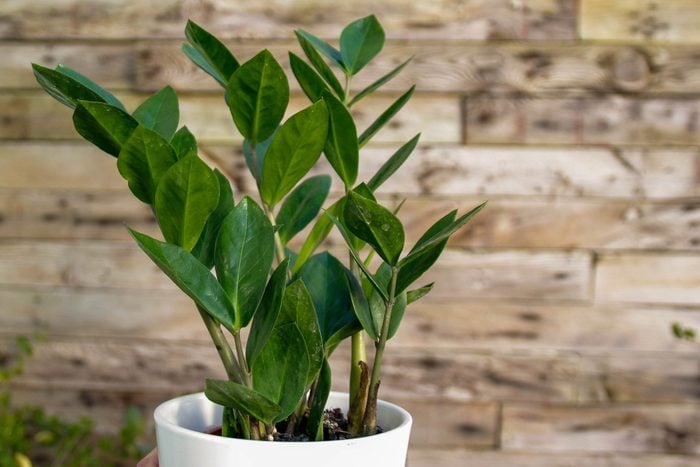
ZZ plant
Zamioculcas zamiifolia
Light exposure needs: Low to bright light (indirect)
“Among the most indestructible of houseplants, the ZZ plant can go a month without water if it has to, thanks to its thick, tuberous roots,” Hancock says. This plant, also called a Zanzibar gem, takes low to bright indirect light and thrives in homes with average temperatures and humidity. If you’re looking for something color-changing, a new variety called Raven features foliage that starts out lime green before “maturing to a stunning purple-black tone,” says Hancock. If needed, repot it during the spring or summer, and check out these tips for caring for a ZZ plant.
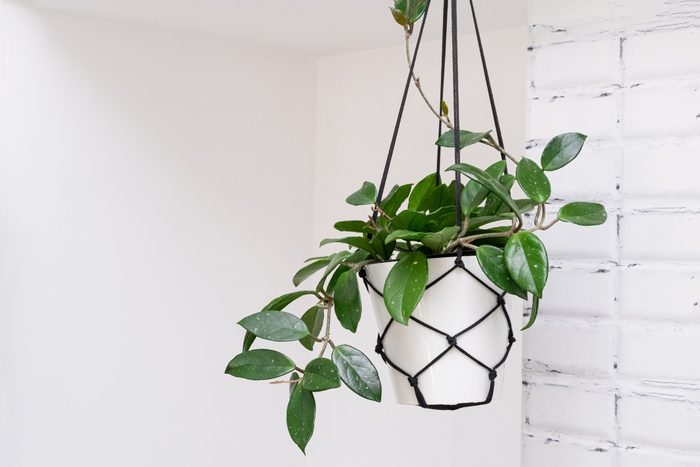
Hoya
Hoya carnosa
Light exposure needs: Bright light (indirect)
Those with a brown thumb will be happy to hear that hoyas can tolerate low light and extreme drought conditions—even going for weeks without water. As a flowering plant, they do need brighter, indirect light to bloom, so if you want to enjoy their clusters of star-shaped, fragrant flowers, it’s best to grow them in a brighter window. Low light isn’t a problem if you don’t mind missing out on their blooms. Looking for something unique? The Hoya compacta, or rope plant, has crinkly leaves that curl and twist around the stem, providing fabulous texture.
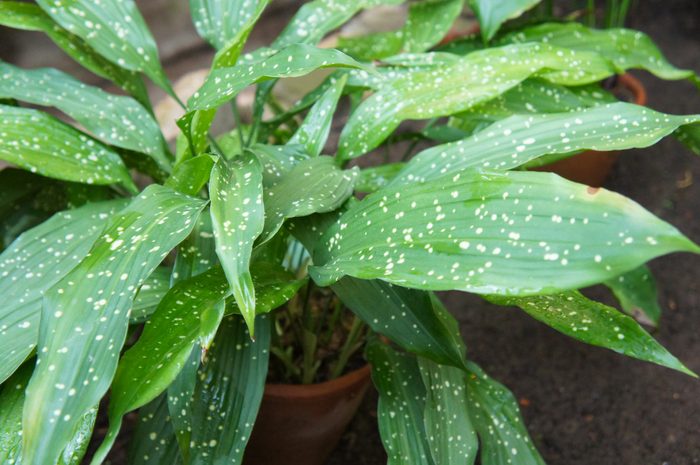
Cast iron plant
Aspidistra elatior
Light exposure needs: Low light
Tolerating heavy shade and even drought, the cast iron plant is as tough as it sounds. A native of China and Japan, it has glossy, dark green leaves and can produce significant flowers, although it seldom blooms when kept as a houseplant. “It’s very tolerant of neglect,” says Leilani Shannon, owner of Dutch Mill Florist in Bismarck, North Dakota, so it can be great for the gardening newbie looking to buy something from a plant subscription box. Some varieties of these low-light cast iron plants have variegated leaves and can even last for decades.
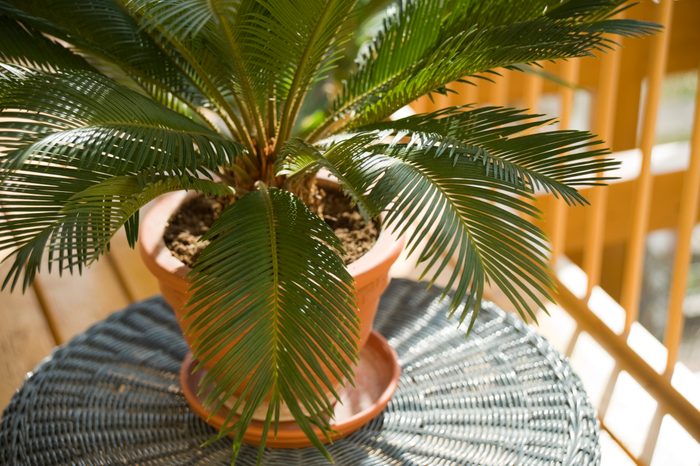
Sago palm
Cycas revoluta
Light exposure needs: Medium to bright light (direct)
With its stiff, feathery leaves and rugged-looking trunk, this ancient tropical plant adds textural interest to almost any setting. The sago palm only puts out one frond (the leaf-like part of a palm) each year and likes being pot-bound, so it’s an excellent choice for your home, office or classroom. It thrives best with a few hours of direct morning or afternoon sun but will tolerate even lower light conditions as well. For those who think plants are the new pets, we love a low-maintenance watering schedule. The sago palm’s soil should be allowed to go dry, almost like a cactus, before it needs water.
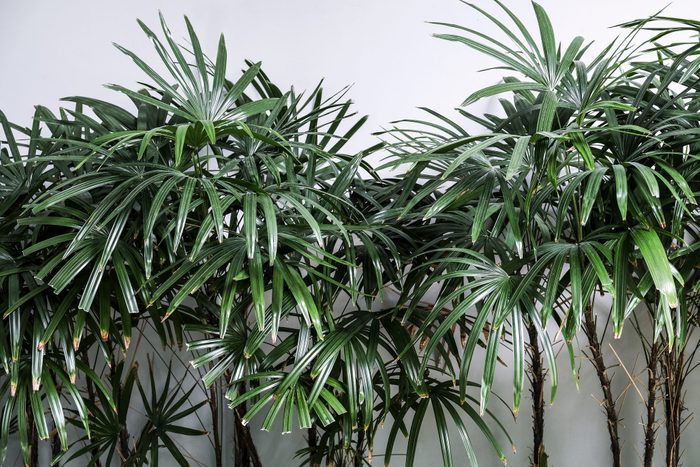
Lady palm
Rhapis excelsa
Light exposure needs: Low to bright light (indirect) or artificial light
Lady palms have what’s called palmate leaves—leaves that look like an open hand—along with stems that grow in clusters, giving them an attractive, full appearance. These slow-growing plants need filtered, indirect light (or artificial light), along with large containers. And because they appreciate a summer vacation outside to get additional sunlight, water and humidity, you can take advantage of the health benefits of gardening.
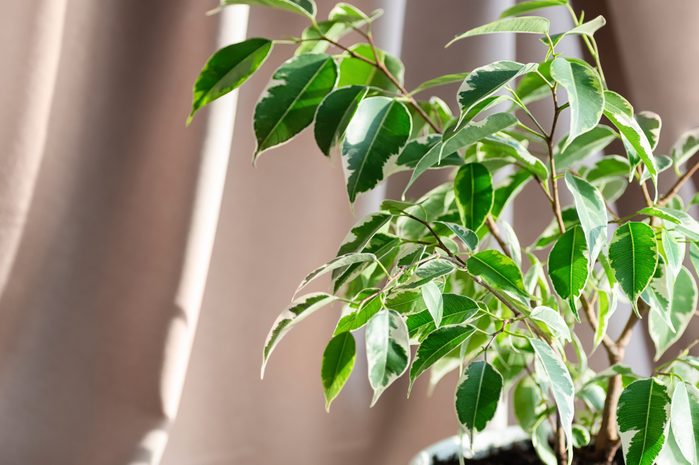
Weeping fig
Ficus Benjamina
Light exposure needs: Bright light (indirect) or artificial light
Weeping figs have a reputation for being hard to grow—and they can be finicky—but their beauty makes them worth the effort and the perfect living room plant. These low-light indoor plants from South Asia grow best in bright, indirect light. You’ll love that they only need watering when the top few inches of soil are dry. And while the leaves can turn yellow and drop when overwatered (or when experiencing a sudden change in light exposure or temperature), don’t worry. Weeping fig plants usually put out new leaves and recover once they’ve adjusted to their new setting.
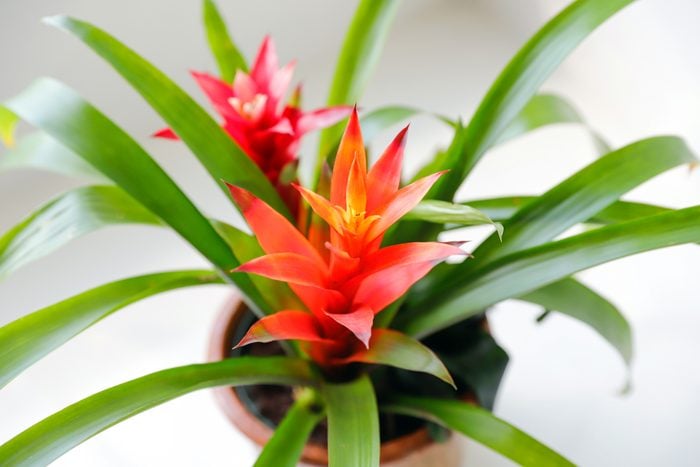
Bromeliad
Bromeliaceae
Light exposure needs: Medium to bright light (indirect)
With their exotic form and colors, bromeliads are often seen in shades of pink, red, orange and yellow. While they are a low-light option, they may lose some of their color, depending on where they’re placed. If you notice their leaves become long, floppy and mostly green, simply move them near a window with brighter, indirect light (try keeping the blinds splintered open). Still, avoid putting them in a spot with harsh afternoon sun, which can burn the leaves. While they are a popular low-light indoor plant, bromeliads do require a bit more care when it comes to watering. They can be sensitive to tap water and prefer distilled water or rainwater poured in the centers of the plants.
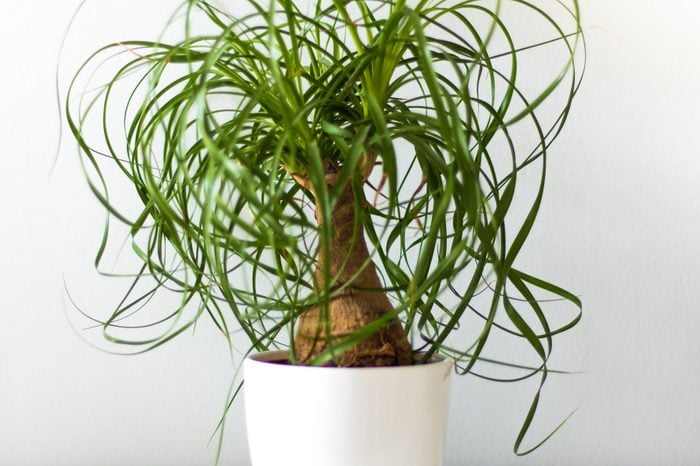
Ponytail palm
Beaucarnea recurvata
Light exposure needs: Bright light (indirect or direct)
Named for the long leaves that grow from their bulb-like trunks, ponytail palms are succulents, making them the perfect option for a low-light indoor plant. Slow-growing and drought tolerant, these are members of the Agave genus of plants, so they’re not actually palms. They thrive in bright, indirect light (although they can handle direct light as well), with dry conditions. You’ll love that they only need watering every two to three weeks, and if the leaf tips turn brown and crispy, just snip them off to refresh the plant’s good looks.
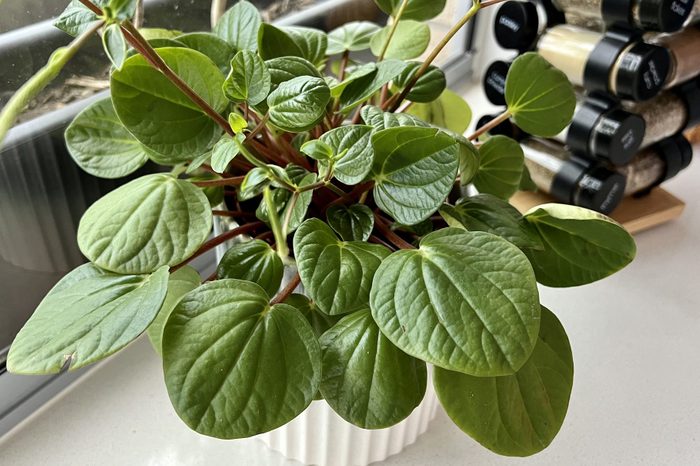
Peperomia
Peperomia
Light exposure needs: Medium to bright light (indirect)
There are more than 1,000 species of peperomias to choose from, and they flourish in medium to bright indirect light (the brighter, the better). They do well in average home temperatures, but these rubber-like plants do require higher humidity, which means frequent misting with a spray bottle. (Just spray the fleshy leaves when the soil feels dry.) They are slow-growing and stay relatively small, which makes them ideal for tight spots in your home or office. These low-light indoor plants would look especially great in a small pot on a nightstand.
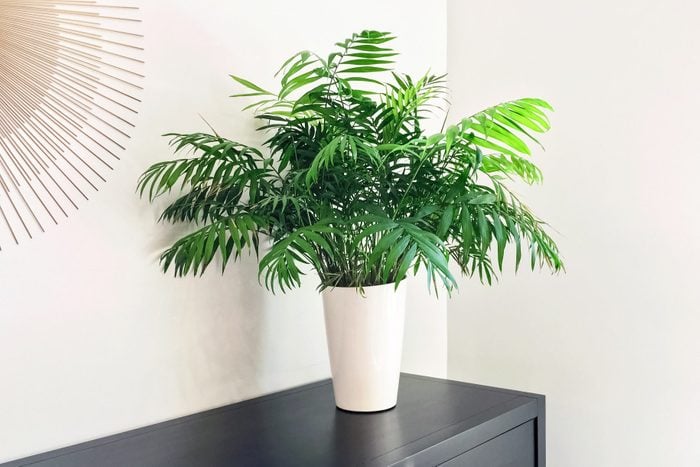
Parlor palm
Chamaedorea elegans
Light exposure needs: Low to bright light (indirect)
Graceful and easy to care for, parlor palms (also marketed as Bella palms or Neanthe palms) can grow in a variety of spaces in your home. They aren’t just for the corners of dimly lit rooms or for tabletops, bookshelves or office desks (though they look great there as well). While they like bright, indirect light, they adapt to lower lighting conditions, which makes them great for a hall or entryway.
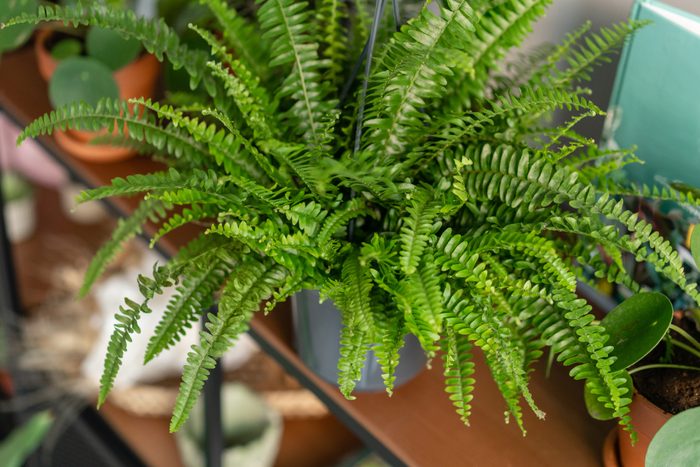
Kimberly queen fern
Nephrolepis cordifolia
Light exposure needs: Medium to bright light (indirect)
This easy-to-grow Australian native has lush, upright and dark green fronds and is known for purifying air. It prefers medium to bright, indirect light, making it great for a sun room or front porch. Just don’t put it in direct sunlight, as the leaves will likely burn. Water the Kimberly queen fern when the soil is dry to the touch or when its fronds turn pale green.
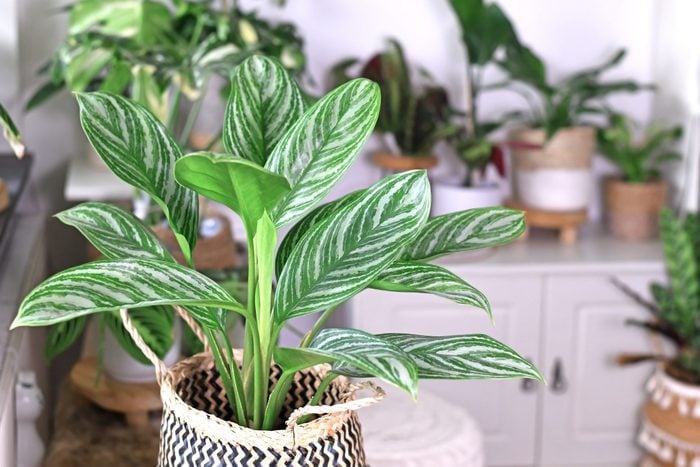
Chinese evergreen
Aglaonema
Light exposure needs: Low to bright light (indirect)
Chinese evergreens are popular low-light indoor plants that come in many varieties. Said to bring good luck, these air-purifying ornamental plants have been grown in Asia for centuries. They require moist soil but not much else, although you will need to avoid cold temperatures and excess sunlight. Wear gloves if you have sensitive skin, as the plant’s juice can cause irritation. One of the most common types of Chinese evergreen, the silver queen is known for the striking pattern of its leaves and would do especially well in a smaller spot, like on a desk or at the end of a bookshelf.
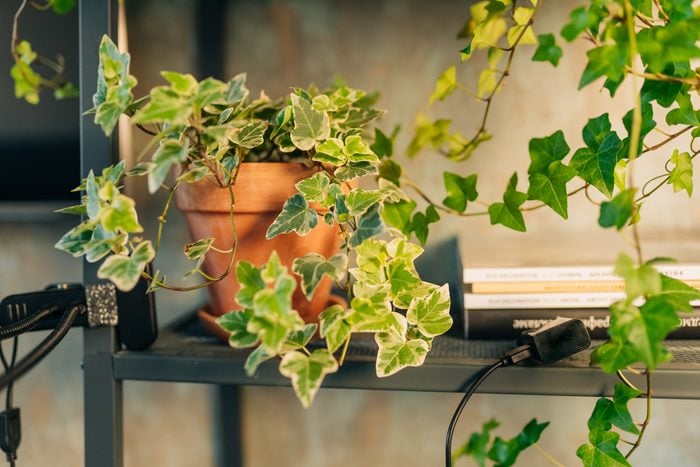
English ivy
Hedera helix
Light exposure needs: Medium light (indirect) or artificial light
Commonly known as one of the best low-light options for a hanging plant or trailing over the sides of pots, English ivy can also be trained to climb a trellis or wire form. Some are solid green while others are touched with yellow, gold or creamy white. Note that while these low-maintenance plants tolerate medium levels of light or artificial light, variegated ivies may turn all green without adequate sunlight.
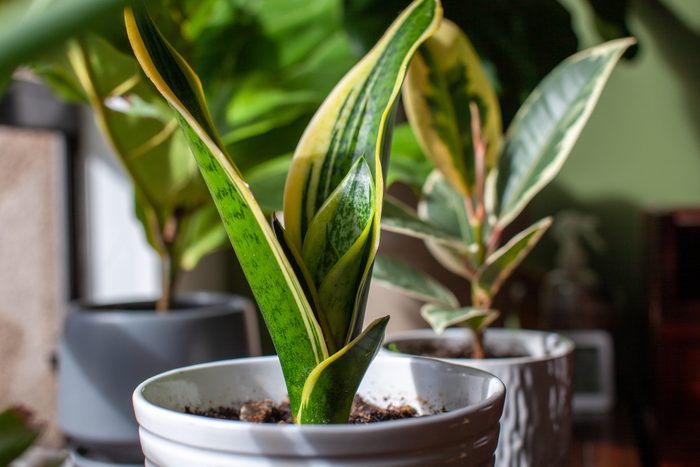
Snake plant
Sansevieria trifasciata
Light exposure needs: Low to bright light (indirect)
Almost impossible to kill, Sansevieria, also known as mother-in-law’s tongue or snake plant, is native to tropical West Africa. This low-light indoor plant has long, tall leaves with yellow or silvery-white stripes. While this is a low-maintenance plant, caring for snake plants does take time. During the growing season, water it regularly, and then cut back significantly on watering during the fall and winter. It needs protection from the hot afternoon sun and tolerates some shade, and it can go in almost any room of your house.
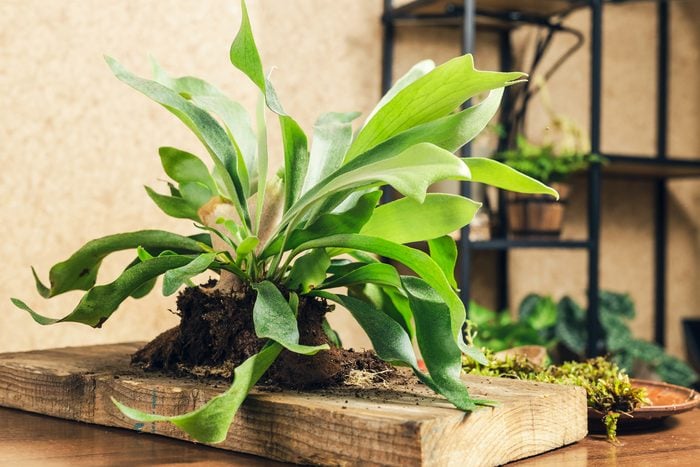
Staghorn fern
Platycerium
Light exposure needs: Bright light (indirect)
One of the best low-light indoor plants, staghorn ferns grow high in rainforest trees in its native South America. Staghorn ferns do well as decorative hanging plants when given the strong, indirect light they’d get from a naturally occurring canopy. In the warmer months, they can be watered once a week by submerging the brown part in water. Then, let it drain before putting it back in place. You can cut back on your watering in the winter months.
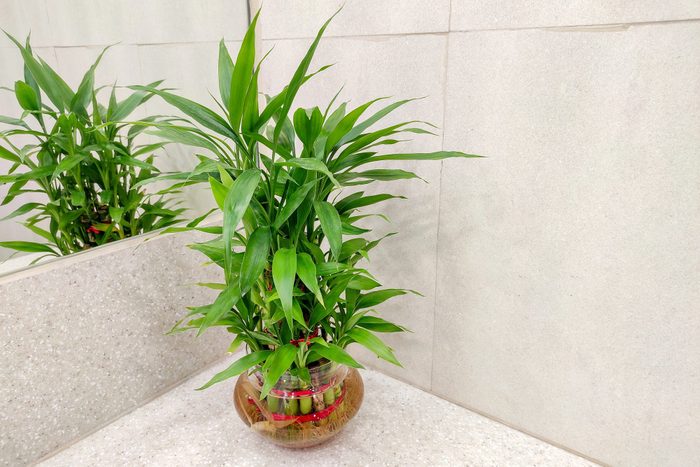
Lucky bamboo
Dracaena sanderiana
Light exposure needs: Low to medium light (indirect)
Dracaena sanderiana, often marketed as lucky bamboo, is known for its straight stalks and lush, green foliage. It’s one of the best low-light indoor plants and is perfect for a desk or tabletop. It’s usually grown in water, with its stems anchored by pebbles or marbles. Look for stems trained into attractive twists, curls or other fun shapes. Some say this low-light houseplant can help boost your feng shui, but we’ll let you be the judge of that.
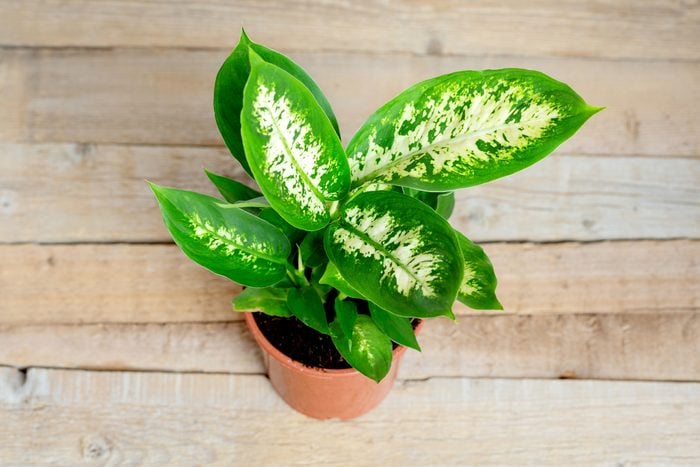
Dumb cane
Dieffenbachia
Light exposure needs: Full shade, low light or bright indirect light
Commonly known as dumb cane, Dieffenbachia is native to Mexico, the West Indies and even as far south as Argentina. This low-light houseplant has straight stems and leaves with yellow, white or cream-colored markings. We love that it can take full shade, although it grows best in bright, indirect sun. Keep it consistently moist, but don’t let the soil stay soggy. Also, keep dumb canes away from young children and pets, and don’t ingest or come into contact with the sap, which is toxic. (Wearing gloves is a simple way to stay safe.)
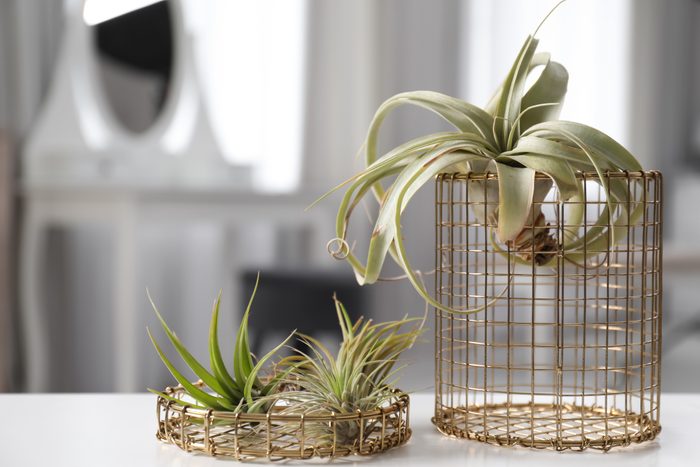
Air plant
Tillandsia
Light exposure needs: Bright light (indirect)
Air plants need bright, filtered sunshine and can grow without soil because they absorb nutrients from the air and water. In dry environments, mist them with a spray bottle one to three times per week. Or you can soak them for about eight hours. Tillandsia is a genus of around 650 plant species, all native to forests, mountains and deserts from northern Mexico, the southeastern United States and the Caribbean to mid-Argentina. In nature, these plants cling to tree branches, bark, rocks and other structures. They’re commonly seen mounted, placed inside seashells or displayed in terrariums.
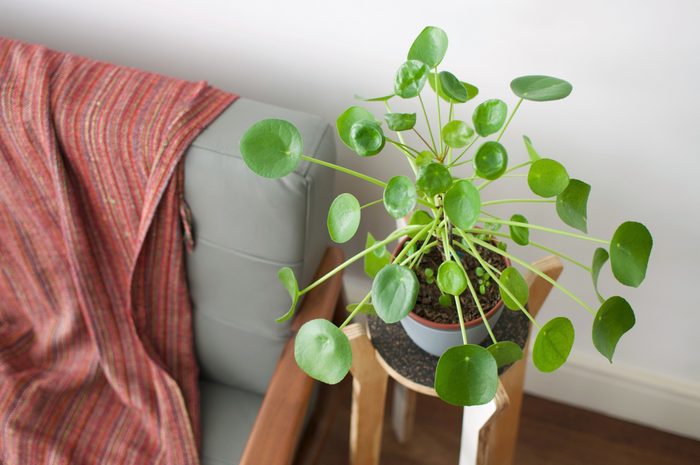
Friendship plant
Pilea involucrata
Light exposure needs: Bright light (indirect)
This pilea is called the friendship plant because it’s so easy to propagate and share. Some people know it as the money plant. Its leaves are velvety soft, oval-shaped and dark green with pale green edges and touches of bronze. But the underside of its leaves is dark red. The friendship plant does best in a warm environment with high humidity and bright, indirect light. Just make sure to water it moderately. You can pinch the stem tips to keep it bushy and compact.
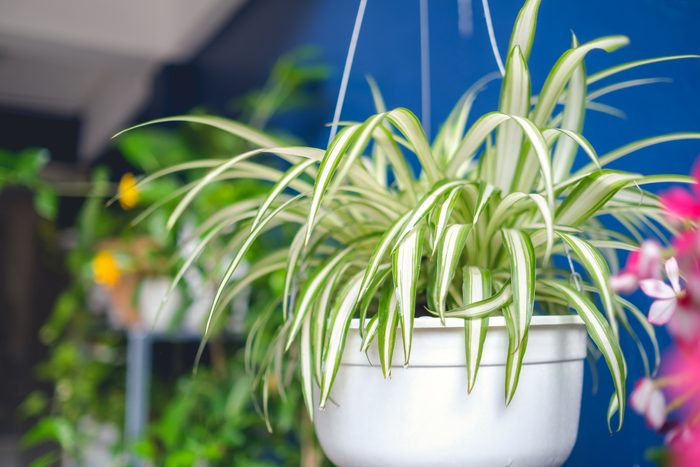
Spider plant
Chlorophytum comosum
Light exposure needs: Bright light (indirect)
Don’t let the name put you off. The spider plant is one of the most adaptable and low-maintenance houseplants. Want to know how to care for your spider plant? Just keep it in well-drained soil and repot this low-light plant in the spring if the roots are growing through the drainage holes (a sign that it’s outgrown its pot). Over time, a mature plant can produce a “spiderette” hanging down from the mother plant, like a baby spider on a web.
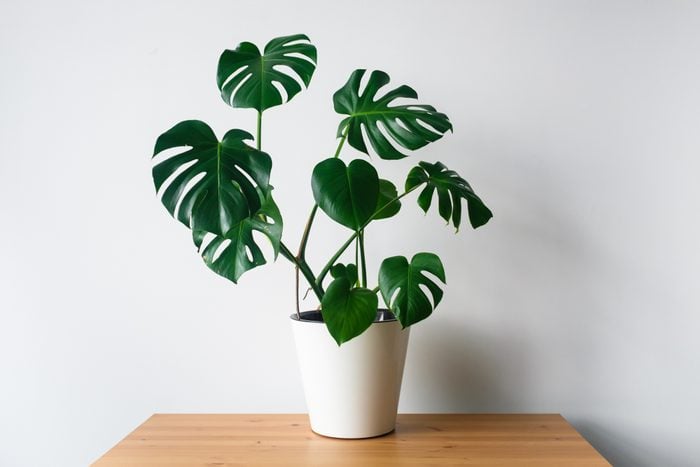
Monstera plant
Monstera deliciosa
Light exposure needs: Low to bright light (indirect)
Also known as the Swiss cheese plant, the monstera plant is one of the best low-light indoor plants, recognizable by its large, split leaves. It’s also a low-maintenance plant that likes bright indoor light (it will show less growth with less light). In its natural habitat, this tropical jungle plant can grow up to 70 feet, but it usually reaches just six to eight feet indoors in a warm, humid location when watered regularly. Learn how to care for a monstera plant, and here’s a tip: Give it a moss-covered pole for structural support.
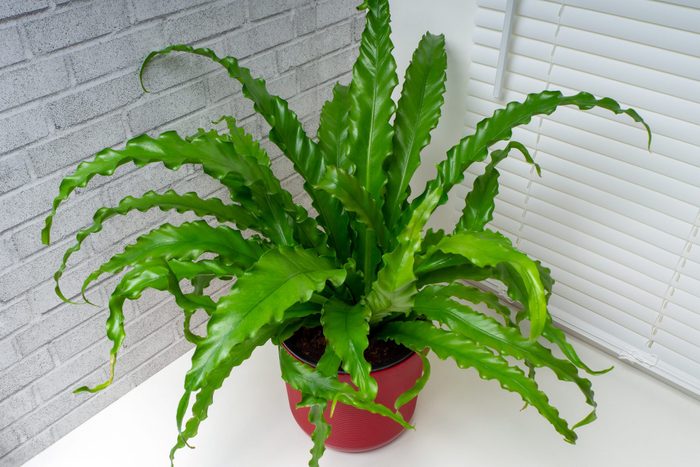
Bird’s nest fern
Asplenium nidus
Light exposure needs: Medium to bright light (indirect)
Asplenium nidus is commonly called the bird’s nest fern because the tightly curled, new fronds that appear in the center look like small bird’s eggs. This lovely, low-light indoor plant is known for its strap-shaped, apple-green foliage, which can be crinkled, wavy or flat. Native to tropical rainforests, the bird’s nest fern plant could definitely thrive outdoors as well—in a front porch area or a side-yard that gets morning sun. When grown indoors, the fern likes warm temperatures, uniformly moist soil and high humidity. That means it makes for a great bathroom plant.
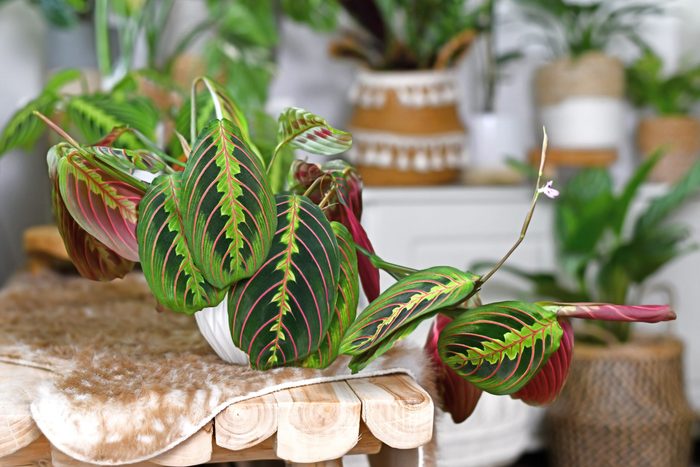
Prayer plant
Maranta leuconeura
Light exposure needs: Low to bright light
Maranta leuconeura is tolerant of low-light conditions and actually prefers indirect sunlight. Its common name, the prayer plant, comes from the way the leaves close vertically in the evening, resembling praying hands. A low-light indoor plant, the prayer plant is easy to care for and loves humidity, so mist the leaves often and keep the soil evenly moist, not wet or soggy. Native to Brazilian rainforests, prayer plants prefer a warm indoor location.
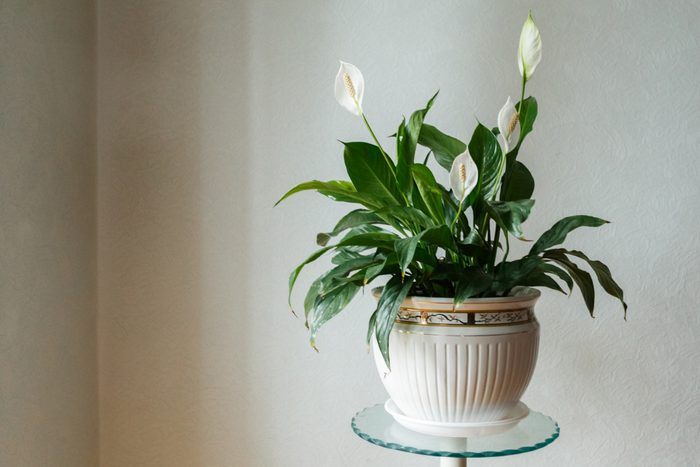
Peace lily
Spathiphyllum
Light exposure needs: Low to bright light (indirect)
Despite their name, these plants aren’t lilies. They’re actually tropical perennials that can live for many years and make for great air-purifying plants. Known for their dark green leaves and white flowers, peace lilies thrive in low light. If you want more flowers, expose them to brighter but indirect light. If the plants are thirsty, they’ll wilt to signal their need for water.
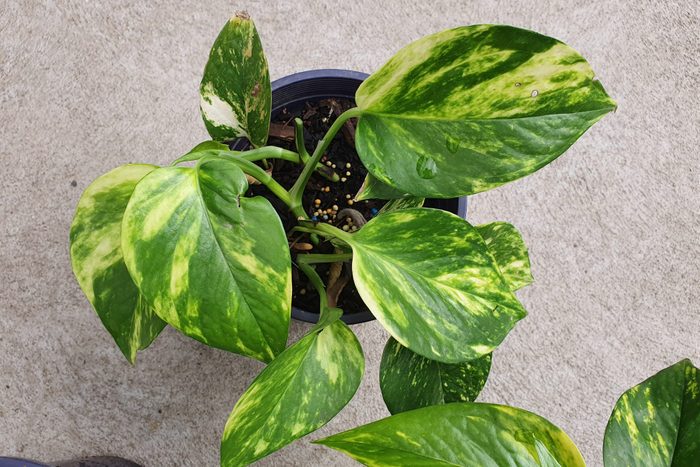
Golden pothos
Epipremnum aureum
Light exposure needs: Low to medium light (indirect)
Although this variegated, low-maintenance plant takes on brighter colors in medium light, the golden pathos, also called Devil’s ivy, will grow in low-light conditions as well. Just make sure to utilize indirect light (you can use a light curtain or blinds to soften it). It’s best to let about half of the soil dry out before you water this plant, and avoid soggy soil. A native of French Polynesia, it is mildly poisonous, so skip this one if you have young children or pets. And make sure to wear gardening gloves if you have sensitive skin.
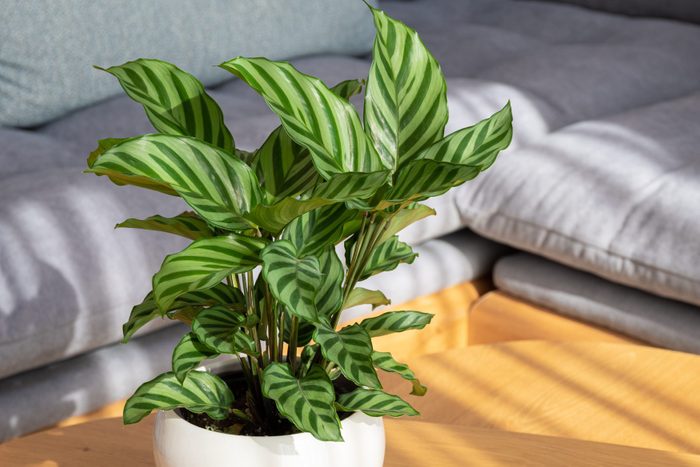
Calathea
Calathea
Light exposure needs: Medium to bright light (indirect)
Looking for a trendy indoor plant with fancy leaves? “Calatheas offer a wide variety of leaf patterns, but they have a reputation for being fussy,” Hancock says. For plant novices, he recommends a network calathea, a European variety that features thick green leaves with intricate, dark veining. Calatheas are great for low-light conditions—in fact, their leaves will singe if the sun exposure is too direct. Make sure to use a spray bottle to keep the humidity up, which will keep their leaves from turning brown. Calatheas are also not toxic to animals.
Additional reporting by Lynn Coulter.
Sources:
- Justin Hancock, horticulturist at Costa Farms
- Leilani Shannon, owner of Dutch Mill Florist in Bismarck, North Dakota
